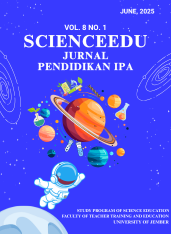The Effectiveness Of Using A Frequency Generator Application In Enhancing Students' Conceptual Understanding Of Determining The Speed Of Sound
DOI:
https://doi.org/10.19184/se.v8i1.53697Keywords:
Application, Concept understanding, Sound propagates quicklyAbstract
This research utilizes a frequency generator application on smartphones with the aim of enhancing students' understanding of the concept of sound resonance in closed organ pipes. The study employs a pretest-posttest design with a control group that was not selected randomly. The method used is non-probabilistic sampling (convenience sampling). The sample used in this study consists of fourth-semester Elementary Teacher Education (PGSD )students who are taking the science learning course. Data collection was conducted using a Concept Understanding Instrument Sheet. The percentage of students' concept understanding above the average increased from 40.1% to 63.4%. This indicates that the concept understanding attained improved after receiving treatment in the form of the frequency generator application. The N-Gain test results yielded an average score of 0.68.
Downloads
References
Arifin, F, A,. Mufit, F,. & Asrizal. (2021). Validity And Practicality Of Interactive Multimedia Based On Cognitive Conflict Integrated New Literacy On Thermodynamic And Mechanical Waves Material For Class XI High School Students. Journal of Physics: Conference Series 1876 012052.
Capriconia, Jenny., & Mufit, F. (2022). Analysis of Concept Understanding and Students' Attitudes towards Learning Physics in Material of Straight Motion. Journal of Research in Science Education.
Chaleon, I. S. & Subramaniam, R., 2008. Three-tier Diagnostic Instrument for Investigating Alternative Conceptions, Asia-Pacific Education Research Association Conference 2008, Singapore, 26-28 November 2008, (Online), (repository.nie.edu).
Delvia, T. F., Mufit, F., & Bustari, M. (2021). Design And Validity Of Physics Teaching Materials Based On Cognitive Conflict Integrated Virtual Laboratory In Atomic Nucleus. Pillar of Physics Education, Vol
Giancoli, D. C. (2001). Fisika edisi kelima jilid 1. Jakarta: Erlangga. 14(1), 5–14.
Imam. (2019). Pengaplikasian Smartphone Sebagian Media Komunikasi Interpersonal di Kalangan Pegawai di Kementrian Agama Kabupaten Aceh Barat. Malaysia: Internasional Journal of Islamic Studies and Social Sciences, 1(2), 344-369.
Hake, R. R. (1998). Interactive-engagement versus traditional methods: A six-thousand-student survey of mechanics test data for introductory physics courses. American Journal of Physics, 66(1), 64–74.
Kryjevskaia, M., Stetzer, M.R., & Heron,P.R.L., 2011. Student Understanding of Wave Behavior at A Boundary: The Limiting Case of Reflection at Fixed and Free Ends. American Journal of Physics, (Online), vol. 75 (9), 508-516
Şengören, S. K., Tanel, R., Kavcar, N., 2009. Students’ Difficulties about the Wave Pulses Propagating On a Rope. Journal of Turkish Science Education, (Online), vol. 6 (1), (https://www.pegem.net), diakses 11 Mei 2016.
Svensonn, T., (2017). Smartphone physics – a smart approach to practical work in science education?, Degree project, Department of Mathematics and Science Education, Stockholms University.
Sutopo., 2016. Pemahaman Mahasiswa Tentang Konsep-Konsep Dasar Gelombang Mekanik. Jurnal Pendidikan Fisika Indonesia, (Online), vol. 12 (1), 41-53
Tanel, R., Sengören, S. K., Kavcar, N., 2008. Prospective Physics Teachers’ Ideas and Drawings about the Reflection and Transmission of Mechanical Waves. Lat. Am. J. Phys. Educ, (Online), vol. 2 (2)
Tipler, P. A. (1998). Fisika untuk sains dan teknik. Jakarta: Erlangga, 1(2), 3.
Wittmann, M. C., Steinberg, R. N., Redish, E. F., 1999. Making Sense of Students Making Sense of Mechanical Waves. The Physics Teacher, (Online), vol. 37, 15–21, (http://perlnet.umaine.edu), diakses 19 April 2016.


